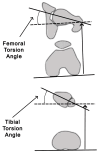Radiological Approach to Assessment of Lower-Limb Alignment-Coronal and Transverse Plane Analysis
- PMID: 39598119
- PMCID: PMC11595539
- DOI: 10.3390/jcm13226975
Radiological Approach to Assessment of Lower-Limb Alignment-Coronal and Transverse Plane Analysis
Abstract
Lower-limb alignment deformities constitute a significant clinical concern, as they can lead to serious complications, including progressive degenerative diseases and disabilities. Rotational deformities may give rise to conditions such as joint arthrosis, patellar instability, and the degeneration of the patellofemoral cartilage. Therefore, a comprehensive evaluation of lower-limb alignment is essential for the effective patient management, preoperative planning, and successful correction of these deformities. The primary assessment method employs full-length standing radiographs in the anteroposterior (AP) projection, which facilitates accurate measurements of the anatomical and mechanical axes of the lower limb, including angles and deviations. The outcomes of this analysis are vital for the meticulous planning of osteotomy and total knee arthroplasty (TKA). In addition, computed tomography (CT) provides a specialized approach for the precise evaluation of femoral and tibial rotation. In this area, there are potential opportunities for the implementation of AI-based automated measurement systems.
Keywords: X-ray imaging; computed tomography; lower-limb alignment; osteotomy; rotational deformities.
Conflict of interest statement
The authors declare no conflicts of interest.
Figures
References
-
- Sheehy L., Cooke T.D.V. Radiographic assessment of leg alignment and grading of knee osteoarthritis: A critical review. World J. Rheumatol. 2015;5:69–81. doi: 10.5499/wjr.v5.i2.69. - DOI
-
- Sabharwal S., Zhao C., McKeon J., Melaghari T., Blacksin M., Wenekor C. Reliability analysis for radiographic measurement of limb length discrepancy: Full-length standing anteroposterior radiograph versus scanogram. J. Pediatr. Orthop. 2006;27:46–50. doi: 10.1097/01.bpo.0000242444.26929.9f. - DOI - PubMed
Publication types
LinkOut - more resources
Full Text Sources




